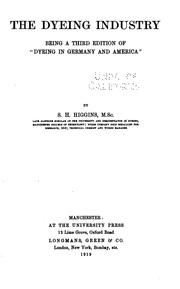Check nearby libraries
Buy this book

The author's bio from the title page reads:
S.H. Higgins, M.Sc.. Late Gartside Scholar of the University [of Manchester] and Demonstrator in Dyeing, Manchester College of Technology; Dyers Company Gold Medallist for Research, 1913; Technical Chemist and Works Manager
Check nearby libraries
Buy this book

Previews available in: English
Showing 2 featured editions. View all 2 editions?
| Edition | Availability |
|---|---|
| 1 |
bbbb
|
| 2 |
aaaa
Libraries near you:
WorldCat
|
Book Details
Edition Notes
Classifications
The Physical Object
ID Numbers
Excerpts
Caustic soda boiling is found to have no deleterious action on cellulose, even on boiling with that solution for 40 hours under pressure. Moreover, weak caustic soda solution is an ideal cleansing agent for textiles, since it removes the waxes by saponification; it is the best hydrolysing agent for proteins, and it eliminates the pectic matter from the fibre. Perhaps the most important point in bleaching is to have a safe method of separating the cellulose. Only safe methods can survive. A method might be very scientific and economical, but if it results in an occasional lot of goods being "tendered," then the economy of the method disappears and the method cannot survive. In fact, methods which require careful scientific control in order to save tendering do not commend themselves to bleachers; methods which are not risky and can be entrusted to workmen not scientifically trained are preferred.
Page 101,
added by Katharine Hadow.
In Germany there is a tendency for businesses to come to a common agreement. A kind of executive government of the heads of the various businesses is formed, and they agree upon a joint government ruling output and sales. They also fix the home price, and sometimes the "kartel," for such is the arrangement termed, pays a bounty on exports if there is any loss occasioned by being compelled to sell at a low price abroad. The loss is thus distributed among the whole of the businesses and does not cripple single concerns. The kartels differ from the present form of most of the American trusts in that they have not advanced to a unified management of production...
Page 131-132,
added by Katharine Hadow.
It demonstrates that the book describes not only the technical production and use of dyes, but also the market in which they were traded.
The development of the Bayer firm is interesting as showing the change from the sale of natural colouring matters, as indigo and safflower, to the manufacture of magenta and its congeners in 1860, and then to the production of alizarine and its derivatives in 1870. Later, they introduced their benzo-purpurines and delta-purpurines, which were the first substantive cotton colours, while shortly afterwards they brought out a whole series of this class of colours.... The Bayer firm has advanced very rapidly until now it is one of the most important. It is significant in this connection to note that they have the most patents, 1000 German and 1200 foreign, and at the time of the author’s visit employed the most chemists.
Page 136,
added by Katharine Hadow.
This passage adds interest to Bayer's 1906 book on fabric dyeing, at https://openlibrary.org/works/OL16750347W/Garment_dyeing
Community Reviews (0)
Feedback?| July 14, 2020 | Edited by MARC Bot | remove fake subjects |
| July 6, 2015 | Edited by Katharine Hadow | What It's About, and excerpts |
| May 5, 2010 | Edited by EdwardBot | add Accessible book tag |
| April 28, 2010 | Edited by Open Library Bot | Linked existing covers to the work. |
| December 9, 2009 | Created by WorkBot | add works page |











